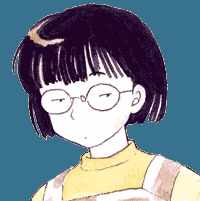

New Year's Special Project Rumiko Takahashi and Moto Hagio
Translation by: Harley Acres
I have been paying attention to Moto Hagio since her debut work!
I bought her first book The Poe Clan, and I've always wanted to meet her!
Rumiko Takahashi New Year's Special Program
The Discussion of Red Bouquet
Rumiko Takahashi, who has been a fan of Moto Hagio's for a long time, asked for her autograph on her book Nanohana (なのはな) (Flower Comics Special, published in March, 2012). When she asked for her autograph, Hagio-san invited her to her atelier, saying, "If that's the case, let's meet!
Although they are both fans of each other's works, this was the first time they had ever had a chance to talk. What is the content of their conversation?
I had to read it. -Takahashi

Takahashi: Nanohana was released in the spring and became a hot topic in newspapers and magazines. Shortly thereafter, you were awarded the Order of the Purple Ribbon in the Spring, and when I saw you interviewed on TV about this work, I knew I had to read it, so I got a copy. [1]
Hagio: Well, thank you very much. I started work on Nanohana after the Great East Japan Earthquake in March 2011, followed by the accident at the nuclear power plant, and when I was still feeling uneasy, a friend of mine organized a cherry blossom viewing party with the idea of "doing what we can for the time being and reviving the economy. [2]
Takahashi: Immediately after the earthquake, everyone wanted to do something, but they didn't know what to do.
Hagio: That's right. The topic came up, and I learned that there was a group that was experimenting with planting plants while doing studies on how they might aid in decontaminating radiation. That was the inspiration.
Takahashi: You must have given a lot of thought to your presentation.
Hagio: Fortunately, the editorial board gave us permission right away, but we knew we needed to have the dialogue checked as soon as possible, so we tried to proceed much faster than usual. [3]
Hagio: Rumiko-san, did you read shonen manga growing up?
Takahashi: Yes, since I had an older brother. [4] Occasionally I read shojo manga when I was able to buy them. Though I didn't always understand what was going on in the story.
Hagio: I read all kinds of magazines by borrowing and lending with friends or through bookstores. Did you start drawing when you were very young?
Takahashi: My father liked to draw pictures. So, it was a natural part of our play to ask him to draw something for us. Before I knew it I had started drawing as well. [5]
Hagio: So your father was an influence?
Takahashi: Yes. And my older brothers didn't draw. So when I drew, my parents were very happy and praised me a lot. So I was being flattered and encouraged to paint.
Hagio: I liked drawing too. I also liked to make up stories, so I would make up original picture stories (紙芝居/kamishibai) and play with them.
Takahashi: It's like "eureka!"
The interior of Makoto-chan's mouth was painted in by a so-called professional.
Takahashi: Who is your favorite mangaka...?Hagio: It's still Osamu Tezuka-sensei. I was working on Ten Billion Days and One Hundred Billion Nights (百億の昼とてづかおさむせんせい千億の夜) (original story by Ryu Mitsuse 1977~1978) in Weekly Shonen Champion. And while I was doing that Tezuka-sensei was also drawing...
Takahashi: Black Jack (ブラック・ジャック) (1973-1978).
Hagio: Yes. I remember how happy I was to see our names in the same magazine together. Did you ever work as an assistant or help out other mangaka?
Takahashi: I was lucky to have been able to visit and work with Kazuo Umezu-sensei once before my debut. [6]
Hagio: Just once?

Takahashi: Yes, now that I think about it, I think that was not because Umezu-sensei needed an assistant, but because my editor wanted to show me a professional workplace...
Hagio: And how did that go...?
Takahashi: I think we were promised three visits, but after two times, he said, "That's enough."
Hagio: Is that where you first saw a so-called professional manuscript?
Takahashi: I thought it looked so high-quality. It was so beautiful. Makoto-chan (まことちゃん) was serialized in Weekly Shonen Sunday at that time. I painted the solid area inside of Makoto's mouth.
Hagio: Do you even remember what was in the manuscript at that time?
Takahashi: Oh yes, I remember it well. It was a story about Makoto-chan and his family going to a video arcade... I helped really only once, but sometimes in books and such its presented like "I was Kazuo Umezu's assistant" (laughs).
Hagio: Now the truth comes out.
I did my best with the cat ears on. -Hagio

Takahashi: I'm so excited to see your workplace today!!
Hagio: These are the tools I usually use. When I sit at my desk and hold a pen like this... the cat comes and sits on my lap (laughs).
Takahashi: (laughs) Like, pay attention~?
Hagio: I guess so.
Takahashi: Do you use a computer too?
Hagio: The black and white work is mostly done by hand. The color is done by using effects and expressions that can only be done by machine.
Hagio: I use it when I feel like it.
Takahashi: I tend to do things by hand. I used to use a brush for solid colors, but one day, my assistant was painting with a magic marker...
Hagio: "What the hell happened to the manuscript?" you shouted?
Takahashi: No, then I did it myself and said, "Wow, this is so easy. Magic markers are so cool" (laughs).
Hagio: (laughs)
Takahashi: What is this little plaster figure? Why is it in your work gear?
Hagio: Oh, this is what I use to get a drawing of a person's head from various angles (looking from above and from the side).
Takahashi: I see!
Hagio: I found it and bought it when I was traveling abroad. I believe it's a statue of Franz Joseph of the Habsburg royal family in Austria.
Takahashi: Was there a particular point in choosing him? Like a favorite face?
Hagio: I think primarily it's the size, you can hold it with one hand, and the fact that the ears are showing (and not hidden by hair, etc.).
It's my kind of SF world! -Hagio
Hagio: You have been drawing a weekly series without much of a break, huh.Takahashi: I sort of have a belief that if I am going to work, I want to do it without taking a break.
Hagio: That's amazing! It's like you're saying, "I'm not hanging it up now!"?
Takahashi: Yes, when I was going over 100 pages at an editorial meeting, I thought, "It's done!" But when I went back to the manuscript, I found that nothing was truly ever done!
Hagio: Oh, I can understand that feeling. I can recall Rumiko-san's debut work Katte na Yatsura (勝手なやつら) in Weekly Shonen Sunday (published in No. 28, 1978) was so funny. I really remember it well... I was glad to see it was the sort of sci-fi world that I really like. In the vein of Ray Bradbury and Kurt Vonnegut. [7]
Takahashi: But to tell the truth, I was most influenced by Japanese authors such as Shinichi Hoshi and Kazumasa Hirai, and I have not read many foreign works. [8] Bradbury had his work made into a manga by you, Hagio-san, so I've read that... (It was published intermittently in Weekly Margaret from 1977 to 1978). [9]
Hagio: Oh, well, thank you very much. But the worldview and the sharpness of the work are already in that vein.
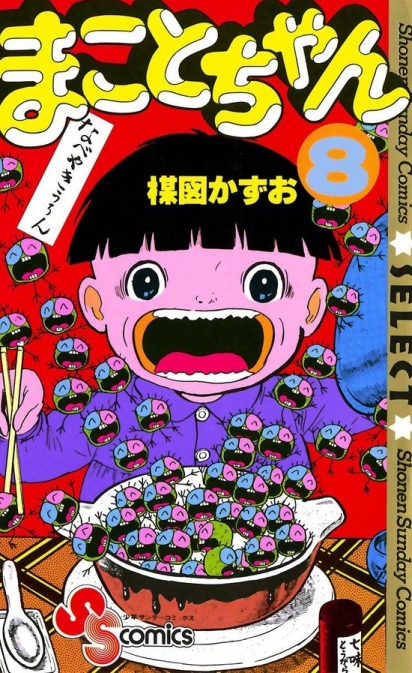
It was a pleasure to view it as a fellow artist. -Takahashi
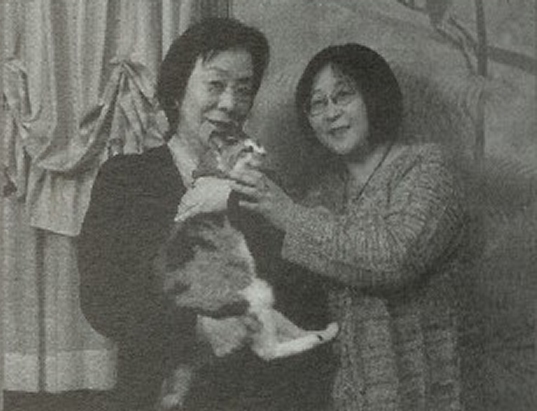
Takahashi: I have heard that your house has a lot of cats. How many cats do you have now?
Hagio: About seven cats if you include the ones that come and go. Some cats have their own territory in the house, and they are separated from each other. I see a lot of animals in Rumiko-san's manga.
Takahashi: My family couldn't keep animals because our house was a doctor's office. So, to tell the truth, I have never had a pet. But I like animals.
Hagio: I didn't get that impression from your work. There are so many cute and unique animal characters.
Takahashi: Animals are fun to look at and draw. I think about things like, "why are chihuahuas tugging on things so much?" or "are sea lions like dogs?"
Hagio: Speaking of animals, I was invited to go to Africa to see animals in the wild. I went twice.
Takahashi: Oh, that's awesome.
Hagio: The types and conditions of the animals are different depending on the season in Africa, so when I go there, I think, "I'll go see that again next time."
Hagio: Rumiko-san, have you been abroad?
Takahashi: I went to Mexico to see the pyramids. The climb was hard. [10]
Hagio: That is quite a hard journey.
Takahashi: I like pyramids. Also, I've been overseas for various events for comics. I went to "Comic-Con International" several times. [11]
Hagio: I also went to San Diego in 2010. Also, in 2012, I participated in the Japan Expo in Paris and made a doujinshi.
Takahashi: Hagio-san, you made a doujinshi? What's it about?
Hagio: It was a French translation of Leo-kun (レオくん) with editorial permission. [12] With the promise that it would be sold exclusively at French events.
Takahashi: Japanese manga and anime are very popular in France. Did you work as a vendor?
Hagio: Yes, I did my best with my cat ears on. However, I ended up with a large amount of inventory left over.. (laughs)..
Takahashi: That's too bad...
Stick to the basics -Takahashi
Takahashi: In your recent Anywhere but Here (ここではない★どこか/Koko de wa nai dokoka) (2006~) series of short stories, the story about destroying the piano was very interesting.Hagio: Black Sheep (くろいひつじ/Kuroi Hitsuji) (2006). There were two events in real life that gave birth to that story. The part about "burning down the piano" is almost a true story.
Takahashi: Oh! I was surprised when I read that part, it really had a tremendous impact. I also like Willow Tree (柳の木/Yanagi no Ki) (2007), which I saw at the original exhibition celebrating the 40th anniversary of your debut in 2009.
Hagio: Oh, you came to see that event? Thank you.
Takahashi: I was moved to see so many of Hagio-san's original manuscripts at the art exhibition. And as a mangaka myself, there are a lot of things I can understand when I look at the original drawings. I was able to view it as a fellow artist and enjoy it deeply because of that.
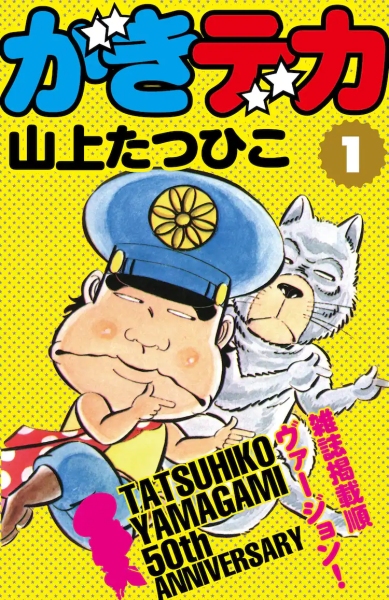
Takahashi: I have been reading Hagio-san's works since the days of your short stories in The Poe Clan (ポーの一族, 1972-1976, published in magazines such as Bessatsu Onna Comic). That was when I became a fan.
Hagio: It was around the time when I was drawing for Bessatsu Shojo Comic doing a lot of one-off stories.
Takahashi: I remember I couldn't get a copy of the The Poe Clan comic, so I had to search for it in bookstores all over town. I was so happy to finally get it.
Hagio: I have a story like that too! I had to hunt all over to find Brat Cop (がきデカ/Gaki Deka) (Weekly Shonen Champion, 1974-1980) (laughs).
Takahashi: (laughs) I've also seen a lot of adaptations of your work, mainly through TV, but I've also checked out some of your works that have been adapted for the stage or made into dramas. There was a drama, There's One! (1人いる!/Hitosu iru!) (NHK, 1977) and Hanshin (半神) (Yumeno Yumensha, 1986, 1988)...
Hagio: How do you feel about having your work animated or dramatized? There have been so many.
Takahashi: I always look forward to seeing how it turns out. Having a work made into a different form means that more people have seen it. I genuinely feel happy about that. I think of it as a reward.
Hagio: And right now you have Kyokai no RINNE (境界のRINNE) (2009-2018) which is running in Shonen Sunday.
Hagio: And I read it every week. It's the first thing I read when I get Sunday.
Takahashi: Thank you so much.
Hagio: I really like Sabato's character.
Takahashi: It is difficult to depict so-called "bad guys." Instead, it's easier to create characters from an everyday perspective, such as ones who feel that "money comes first." [13]
Hagio: You also draw such exquisite characters, even these straight-laced old men. [14]
Takahashi: They're hard to draw because I can't draw cool people. Also, maybe because I work, I feel like I can easily empathize with men who have jobs.
Hagio: In Rumiko-san's manga, the characters call each other by their proper names each time, which is easy to understand. That was intentional, wasn't it?
Takahashi: I'm trying to stick to the basics, but sometimes I think, "Okay, I'm done. ... I'm still going to do my best (laughs).
And so their deep conversation continued late into the night.... [The End]
Footnotes
- [1] The Purple Ribbon is one of the Medals of Honor (褒章/hosho) given by the Japanese government. The Purple Ribbon is specifically given to those who make a major contribution in the fields of academics and arts. Moto Hagio won the Purple Ribbon in 2012, Rumiko Takahashi won in 2020. Other noted mangaka that have won the Purple Ribbon include Shigeru Mizuki (1991), Leiji Matsumoto (2001), Tetsuya Chiba (2002) and Takao Saito (2003) and Katsuhiro Otomo (2013).
- [2] Nanohana (なのはな) is a collection of stories by Moto Hagio dealing with nuclear power in the wake of the Fukushima nuclear power plant meltdown in 2011. Hagio is one of the first mangaka to address the disaster in her works. Rumiko Takahashi contributed a special extra chapter of Inuyasha that takes place after the manga's conclusion to the anthology Heroes Come Back.
- [3] Hagio mentions making sure the editorial board of Big Comic (where she published the stories of Nanohana) were on board before she published as the Fukushima meltdown was a sensitive topic. Hagio did not meet with any serious criticism for her story. This would be in contrast to the experience of the incredibly popular, long-running manga Oishinbo (美味しんぼ) by Tetsu Kariya and Akira Hanasaki which resulted in the manga going on an indefinite hiatus for questioning the safety of the region in the wake of the meltdown. Kariya published the storyline in 2014 and it featured the real life former mayor, Katsutaka Idogawa (井戸川克隆), discussing the frequent nosebleeds he had in the wake of the accident with the main character of the series, newspaper reporter Shiro Yamaoka (山岡士郎). Idogawa was very vocal about his disagreements over the safety of the area in an interview with Kariya that ran in Big Comic Spirits discussing the nuclear accident. Afterwards Minister of the Environment Nobuaki Ishihara (石原伸晃) expressed concern that the depiction in Oishinbo would cause negative rumors.
- [4] Takahashi primarily grew up reading shonen manga because that is what her brothers bought. She discusses this in her interview about Ryoichi Ikegami and also in "Examinging the Source of Masterpieces! Rumiko Takahashi's History" which is where she also discusses discovering the work of Moto Hagio through her friend Yoko Kondo.
- [5] Rumiko Takahashi's father, Mitsuo, was a gynecologist in Niigata. Here she mentions her father enjoying drawing and in 1989 she published a collection of his sumi-e paintings of kappa which he published under the pen name Utsugi Takahashi (高橋卯木).
- [6] This would have been Takahashi's first editor, Shinobu Miyake (三宅克). He is the namesake of Shinobu Miyake of Urusei Yatsura fame. In addition to overseeing Urusei Yatsura he also was the editor of Pro-Golfer Saru (プロゴルファー猿) by Fujiko Fujio A (藤子不二雄Ⓐ) and Makoto-chan (まことちゃん) by Kazuo Umezu (楳図かずお).
- [7] Ray Bradbury (1912-2012) was a very popular American writer of science fiction best known for Farenheit 451, Dandelion Wine, The Martian Chronicles and Something Wicked This Way Comes. Bradbury won three consecutive Seiun Awards for short stories in translation for "The Poems", "The Blue Bottle" and "The Black Ferris" in the early 1970s. Kurt Vonnegut (1922-2007) is an American writer of science fiction and humor best known for Slaughterhouse-Five, Cat's Cradle and Breakfast of Champions. Vonnegut won the Hugo Award for Slaughterhouse-Five and the Seiun Award for The Sirens of Titan. Takahashi herself won the Seiun twice, once for Urusei Yatsura and then again for Mermaid Saga. The anime of Urusei Yatsura won the award, as well as Only You and Beautiful Dreamer. Moto Hagio won the Seiun for Star Red (スター・レッド), A, A′, Silver Triangle (銀の三角) and X + Y.
- [8] Shinichi Hoshi (星新一) (1926-1997) was a influential Japanese science fiction and mystery writer known for writing what he called "short-shorts", stories fewer than four pages. Kazumasa Hirai (平井和正) (1938-2015) was a science fiction novelist best known for 8 Man (8マン), Genma Wars (幻魔大戦) and Wolf Guy (ウルフガイ). Takahashi illustrated a number of his Wolf Guy novels in the early 1980s. He published two interview books of discussions he had with Takahashi entitled The Time We Spoke Endlessly About the Things We Loved (語り尽せ熱愛時代/Kataretsuse netsuai jidai) and The Gentle World of Rumiko Takahashi (高橋留美子の優しい世界/Takahashi Rumiko no Yasashii Sekai) which is his analysis of Maison Ikkoku and Urusei Yatsura Movie 2: Beautiful Dreamer.
- [9] Hagio's adaptation of Bradbury's work is U wa Uchuusen no U (ウは宇宙船のウ) in 1977.
- [10] Rumiko Takahashi had been to Mexico twice by the time of this interview. She frequently mentions it as a special place to her and references visiting the pyramids a number of times in the Q&A found in each issue of Shonen Sunday.
- [11] We have a number of interviews Rumiko Takahashi gave during visit to Comic-Con International including "A Look Through Tinted Glass" and "San Diego Comic-Con Fan Question Session".
- [12] Leo-kun was published in English in Lil Leo from DENPA. The story deals with a little kitten trying to learn about the human world by going to school and going to work and his struggles to adapt.
- [13] Takahashi discusses her philosophy for creating villains in this interview.
- [14] Hagio is referring to Rumiko Takahashi's short stories where she often focused on the lives of older men in stories such as Help, As Long As You Are Here and Middle-Aged Teen.
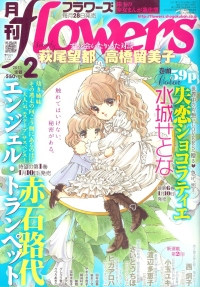
月刊flowers 2013年 2月号
|